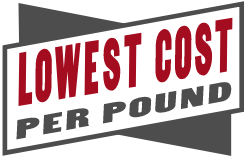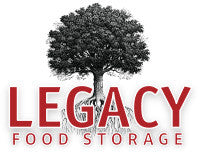
Emergency Food Storage: When Allergies Change Everything
When Benjamin was diagnosed with a severe tree nut allergy at age four, Christina realized their carefully assembled emergency food kit had suddenly become a minefield. The trail mix, granola bars, and even some of the shelf-stable meals she'd stored two years earlier now needed a complete review. What seemed like good planning before his diagnosis could now send him to the hospital.
When you're planning emergency food storage for a family member with allergies, the stakes feel higher. The last thing you want during a crisis is someone having an allergic reaction when medical help might not be available. It also makes your personal preparedness more critical because others are less likely to be able to help in times of need.
Here’s how to build a safe emergency food plan that protects everyone in your family.
Start with What You Know Works
The safest approach is building your emergency supply around foods your family already eats safely. If you rely on certain brands of gluten-free pasta or dairy-free products, start there. Emergency time is not the moment to experiment with new foods.
Keep a running list of brands and products that work for your family. When you find emergency food options that match those ingredients, you'll have confidence they're safe choices. Consider using tools like a food saver or vacuum sealer to extend the shelf life of grocery store items you purchase.
Read Every Label Carefully
Emergency food companies aren’t always fully transparent about ingredients. Some allergens may be hidden in “proprietary” blends or not listed clearly enough online.
Before buying any emergency food package, speak to the company and ask for the full ingredient list. If the company can’t provide it, ask for written confirmation that the allergen in question is not included.
Watch for common hidden allergens in emergency foods:
- Wheat and gluten in seasoning mixes
- Dairy in meat or pasta dishes
- Soy under names like TVP, Lecithin, or Hydrolyzed vegetable protein
- Tree nuts in granola or trail mix
- Eggs in pasta or baked goods
- Any cross-contamination with the manufacturing process
- Modified items, what was it modified with?
- Enriched items, what was it enriched with?
Consider Individual Ingredients Over Meal Packages
Pre-made meal kits often mix in multiple allergens. Buying single ingredients like freeze-dried vegetables, meats, and rice gives you control over every meal. This allows you to assemble safe meals and add additional variety to your stored allergen safe ingredients.
It takes more planning, but you’ll avoid the surprise of hidden allergens. Build your staples first, then add variety with fruits, vegetables, and proteins.
Rotate and Track Expiration Dates
For families with allergies, expired food can be risky because proteins change over time. Keep a simple rotation system. Write “use by” dates clearly on the package or use colored sticker dots to make older stock easier to spot. Setreminders to rotate items out regularly and do quick checks to stay on track.
Make Your Own
For families who want more control, home freeze-dryers now make it possible to create your own long-shelf-life meals. It does take time and money but gives you complete control and variety with recipes you already trust. For more information on this option, we have an article here on what you can expect when purchasing a freeze dryer.
Don’t Forget Shelf-Stable Substitutes
If your family relies on things like dairy alternatives, nut-free spreads, or egg replacers, look for shelf-stable versions. Powdered coconut milk, sunflower seed butter, or ground flax for egg replacement can be lifesavers in storage.
Comfort Foods Matter Too
Emergencies are stressful. Having safe “treats” like gluten-free cookies or a favorite candy can make a huge difference for morale, especially for kids. Just keep in mind that you’ll want to rotate these less shelf stable foods more frequently. . .yum!
Have Backup Plans for Your Backup Plans
Store extra of whatever your family needs to stay safe. If someone requires an EpiPen, keep multiple and check expiration dates often. For critical medications, work with your doctor to maintain an emergency supply, and plan refrigeration options if needed.
Keep emergency contact information for your allergist or pediatrician easily accessible. In a disaster situation, you might need professional guidance about managing allergies when normal routines are disrupted.
Test Everything Before You Need It
Don't wait for an emergency to discover that your "safe" emergency food actually causes reactions. Try every emergency food item you plan to store while life is normal and medical help is available.
The Bottom Line
With a little planning, you can protect your family and make sure your plan is one you can feel confident about. Build around foods you know are safe, document everything, and prepare backups for your backups.
Remember: some emergency food is always better than none. A bag of rice and safe canned meat beats an untested meal that could send someone to the emergency room.
Tags
- All
- 25 year food
- 25 year shelf life food
- 72 hour kit
- Best food storage types
- Best long-term food storage
- Blizzard preparedness
- Budgeting
- canning
- Certified GMO-free Emergency foods
- Certified GMO-free foods
- Coffee
- Comparison of emergency food methods
- Composting tips
- Dangers of genetically modified foods
- dehydrated food
- Edible Wild Plants
- emergcy preparedness
- Emergency Cooking
- Emergency Food
- Emergency food Christmas gifts
- emergency food storage
- Emergency Food Supply
- Emergency food supply recommendations
- Emergency Planning
- Emergency Preparedness
- Emergency preparedness advice
- emergency preparednesss
- Emergency Supplies
- Emergency supplies checklist
- Emergency Survival
- emergency survival gear
- Emergency survival kit checklist
- Emergency Survival skills
- exercise
- Family emergency preparedness
- Family emergency preparedness plan
- Family Preparedness
- Food Storage
- Food storage 25 year shelf life
- Food storage amounts
- Food storage Christmas
- Food storage containers long term
- Food Storage Secrets
- Food storage serving size
- Food storage types compared
- freeze dried food
- Freeze dried food storage
- freeze dried meats
- Freeze-dried emergency food storage
- Fruit Trees
- Gardening
- Getting Started
- Gluten-free food Storage
- Gourmet emergency food
- Healthy food storage
- How much emergency food to store
- Improved emergency preparedness
- Jared Markin
- Jared Matkin
- Legacy Premium
- Lessons learned from Hurricane Sandy
- Lessons learned from natural disasters
- long-term food storage
- Long-term Food Storage Guidelines
- Long-term Food Storage tips
- Long-term water storage
- Mental Emergency Preparedness
- Mental toughness
- Money-saving tips
- Natural disaster planning
- Natural Disasters
- Perfect Christmas gifts
- Pet Emergency preparedness checklist
- Pet Emergency preparedness kit
- Pet Emergency Survival tips
- Pets and Emergency Preparedness
- Plant Foraging
- portable solar panels
- portable solar power
- portable water filters
- protein drinks
- Risk of genetic modification
- Seed saving and storage
- Seed saving guide
- Self-reliance
- Self-reliant practices
- Shelf Life
- Solar Cooking
- Solar Ovens
- Special Dietary needs
- Stranded in a car in a blizzard
- Survival food
- Survival Gear
- survival kit
- Survival kits
- Survival Ovens
- Survival Skills
- survivalist gear
- suvival kit
- Tree Pruning tips
- Tree Trimming basics
- unique ideas
- water bottle with filter
- water filter
- water filter straw
- water filters
- Water Filtration
- water pitcher with filter
- water pitchers with filters
- Water purification
- Wild Food Foraging
- Winter composting
- Winter driving
- Winter preparedness tips
- Winter storm preparedness tips
- Winter Survival







